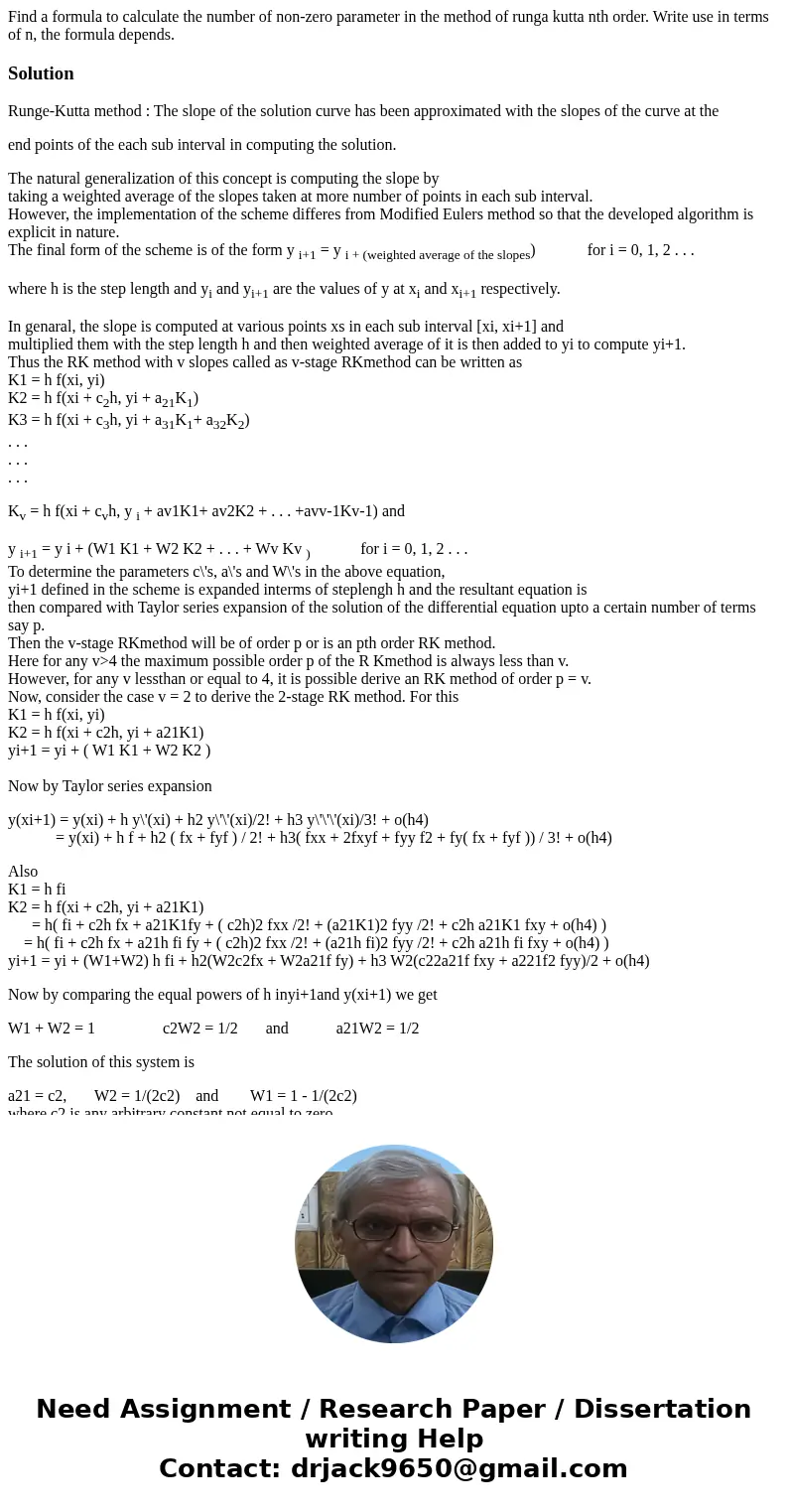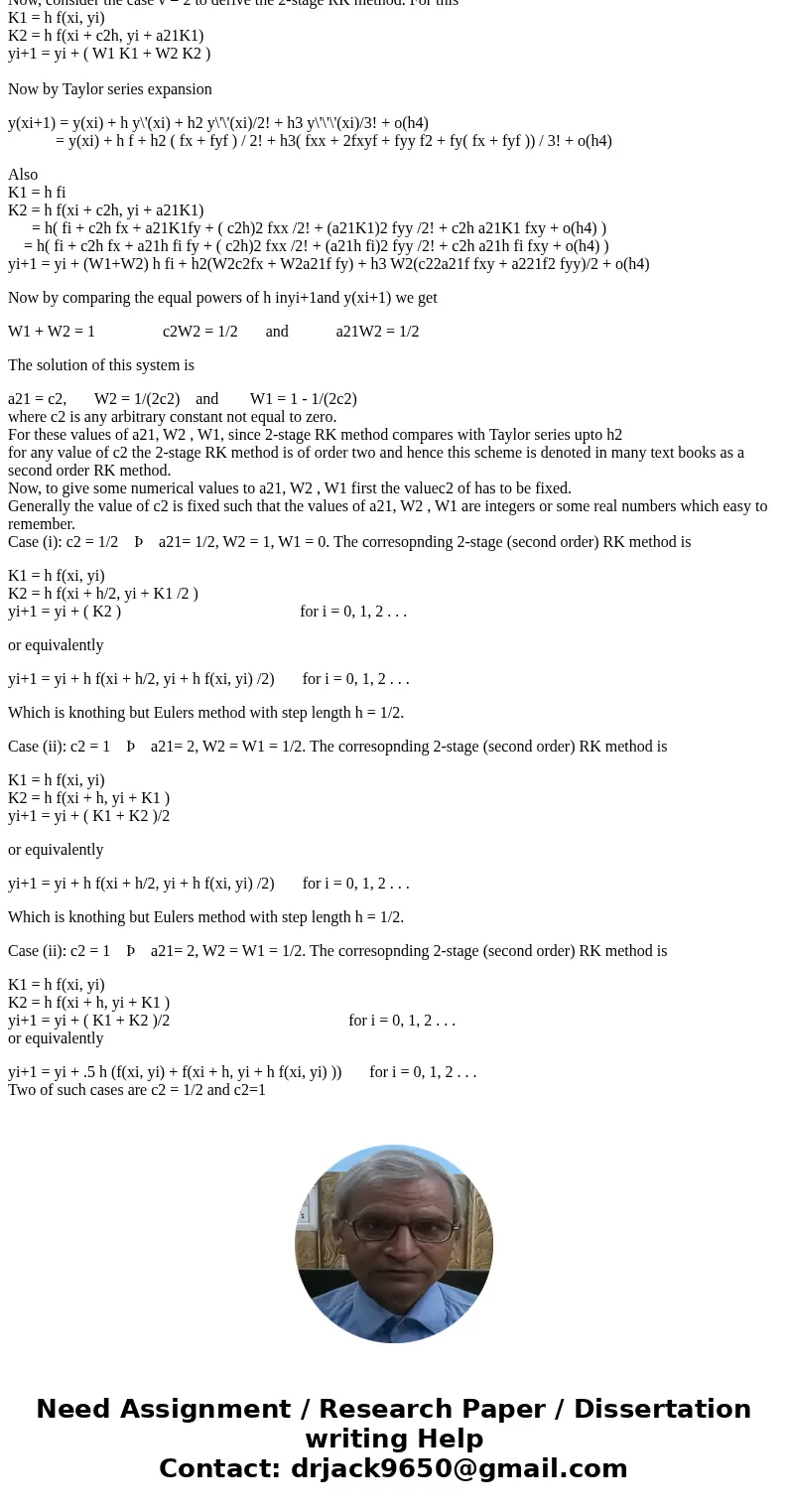Find a formula to calculate the number of nonzero parameter
Solution
Runge-Kutta method : The slope of the solution curve has been approximated with the slopes of the curve at the
end points of the each sub interval in computing the solution.
The natural generalization of this concept is computing the slope by
taking a weighted average of the slopes taken at more number of points in each sub interval.
However, the implementation of the scheme differes from Modified Eulers method so that the developed algorithm is explicit in nature.
The final form of the scheme is of the form y i+1 = y i + (weighted average of the slopes) for i = 0, 1, 2 . . .
where h is the step length and yi and yi+1 are the values of y at xi and xi+1 respectively.
In genaral, the slope is computed at various points xs in each sub interval [xi, xi+1] and
multiplied them with the step length h and then weighted average of it is then added to yi to compute yi+1.
Thus the RK method with v slopes called as v-stage RKmethod can be written as
K1 = h f(xi, yi)
K2 = h f(xi + c2h, yi + a21K1)
K3 = h f(xi + c3h, yi + a31K1+ a32K2)
. . .
. . .
. . .
Kv = h f(xi + cvh, y i + av1K1+ av2K2 + . . . +avv-1Kv-1) and
y i+1 = y i + (W1 K1 + W2 K2 + . . . + Wv Kv ) for i = 0, 1, 2 . . .
To determine the parameters c\'s, a\'s and W\'s in the above equation,
yi+1 defined in the scheme is expanded interms of steplengh h and the resultant equation is
then compared with Taylor series expansion of the solution of the differential equation upto a certain number of terms say p.
Then the v-stage RKmethod will be of order p or is an pth order RK method.
Here for any v>4 the maximum possible order p of the R Kmethod is always less than v.
However, for any v lessthan or equal to 4, it is possible derive an RK method of order p = v.
Now, consider the case v = 2 to derive the 2-stage RK method. For this
K1 = h f(xi, yi)
K2 = h f(xi + c2h, yi + a21K1)
yi+1 = yi + ( W1 K1 + W2 K2 )
Now by Taylor series expansion
y(xi+1) = y(xi) + h y\'(xi) + h2 y\'\'(xi)/2! + h3 y\'\'\'(xi)/3! + o(h4)
= y(xi) + h f + h2 ( fx + fyf ) / 2! + h3( fxx + 2fxyf + fyy f2 + fy( fx + fyf )) / 3! + o(h4)
Also
K1 = h fi
K2 = h f(xi + c2h, yi + a21K1)
= h( fi + c2h fx + a21K1fy + ( c2h)2 fxx /2! + (a21K1)2 fyy /2! + c2h a21K1 fxy + o(h4) )
= h( fi + c2h fx + a21h fi fy + ( c2h)2 fxx /2! + (a21h fi)2 fyy /2! + c2h a21h fi fxy + o(h4) )
yi+1 = yi + (W1+W2) h fi + h2(W2c2fx + W2a21f fy) + h3 W2(c22a21f fxy + a221f2 fyy)/2 + o(h4)
Now by comparing the equal powers of h inyi+1and y(xi+1) we get
W1 + W2 = 1 c2W2 = 1/2 and a21W2 = 1/2
The solution of this system is
a21 = c2, W2 = 1/(2c2) and W1 = 1 - 1/(2c2)
where c2 is any arbitrary constant not equal to zero.
For these values of a21, W2 , W1, since 2-stage RK method compares with Taylor series upto h2
for any value of c2 the 2-stage RK method is of order two and hence this scheme is denoted in many text books as a second order RK method.
Now, to give some numerical values to a21, W2 , W1 first the valuec2 of has to be fixed.
Generally the value of c2 is fixed such that the values of a21, W2 , W1 are integers or some real numbers which easy to remember.
Case (i): c2 = 1/2 Þ a21= 1/2, W2 = 1, W1 = 0. The corresopnding 2-stage (second order) RK method is
K1 = h f(xi, yi)
K2 = h f(xi + h/2, yi + K1 /2 )
yi+1 = yi + ( K2 ) for i = 0, 1, 2 . . .
or equivalently
yi+1 = yi + h f(xi + h/2, yi + h f(xi, yi) /2) for i = 0, 1, 2 . . .
Which is knothing but Eulers method with step length h = 1/2.
Case (ii): c2 = 1 Þ a21= 2, W2 = W1 = 1/2. The corresopnding 2-stage (second order) RK method is
K1 = h f(xi, yi)
K2 = h f(xi + h, yi + K1 )
yi+1 = yi + ( K1 + K2 )/2
or equivalently
yi+1 = yi + h f(xi + h/2, yi + h f(xi, yi) /2) for i = 0, 1, 2 . . .
Which is knothing but Eulers method with step length h = 1/2.
Case (ii): c2 = 1 Þ a21= 2, W2 = W1 = 1/2. The corresopnding 2-stage (second order) RK method is
K1 = h f(xi, yi)
K2 = h f(xi + h, yi + K1 )
yi+1 = yi + ( K1 + K2 )/2 for i = 0, 1, 2 . . .
or equivalently
yi+1 = yi + .5 h (f(xi, yi) + f(xi + h, yi + h f(xi, yi) )) for i = 0, 1, 2 . . .
Two of such cases are c2 = 1/2 and c2=1


 Homework Sourse
Homework Sourse